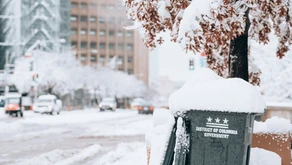Winter weather brings some unique challenges to the typical environmental issues faced by our planet, as the snow and ice become contaminated with pollutants, and the emissions from idling car engines and gas-fueled equipment can negatively impact air quality.
Here are a few eco-friendly tips you can use to protect the environment during the winter:
- Wear layers. Consider wearing a few extra layers of clothes rather than increasing the heating system’s temperature. This easy practice will allow you to save both energy and money. Also, consider wearing clothing made of natural fibers instead of synthetic fibers, which pollute our environment with microplastics when washed.
- De-ice with caution. Some deicers, such as rock salt and calcium chloride, can pose a hazard to children, pets, and the environment because of their harmful effects on aquatic ecosystems. Consider looking for safer, eco-friendly alternatives such as sand and sawdust that apply traction to icy surfaces without using toxic chemicals.
- Switch to energy-efficient lightbulbs. Consider swapping out the traditional incandescent lightbulbs with eco-friendly versions such as light-emitting diodes (LEDs), halogen incandescents, and compact fluorescent lamps (CFLs). You will find that these tend to have an initial higher cost; however, they do last longer and could save you between $30 and $80 in electricity costs over the bulb’s lifetime.
- Don’t leave your car. Leaving the car on for extended periods to wait for it to warm up causes unnecessary increases in emissions and pollution in the air. Therefore, strive to limit this activity to a maximum of 3 minutes.
- Seal all leaks. A common energy waste during winter is air leaks inside and outside your home. Continuous Air leaks are costly and can also cause indoor air quality problems (i.e., moisture). In order to avoid any air leaks, you should inspect all areas where two different materials meet. These holes can be filled in with weather strips and expanding foam installation.





